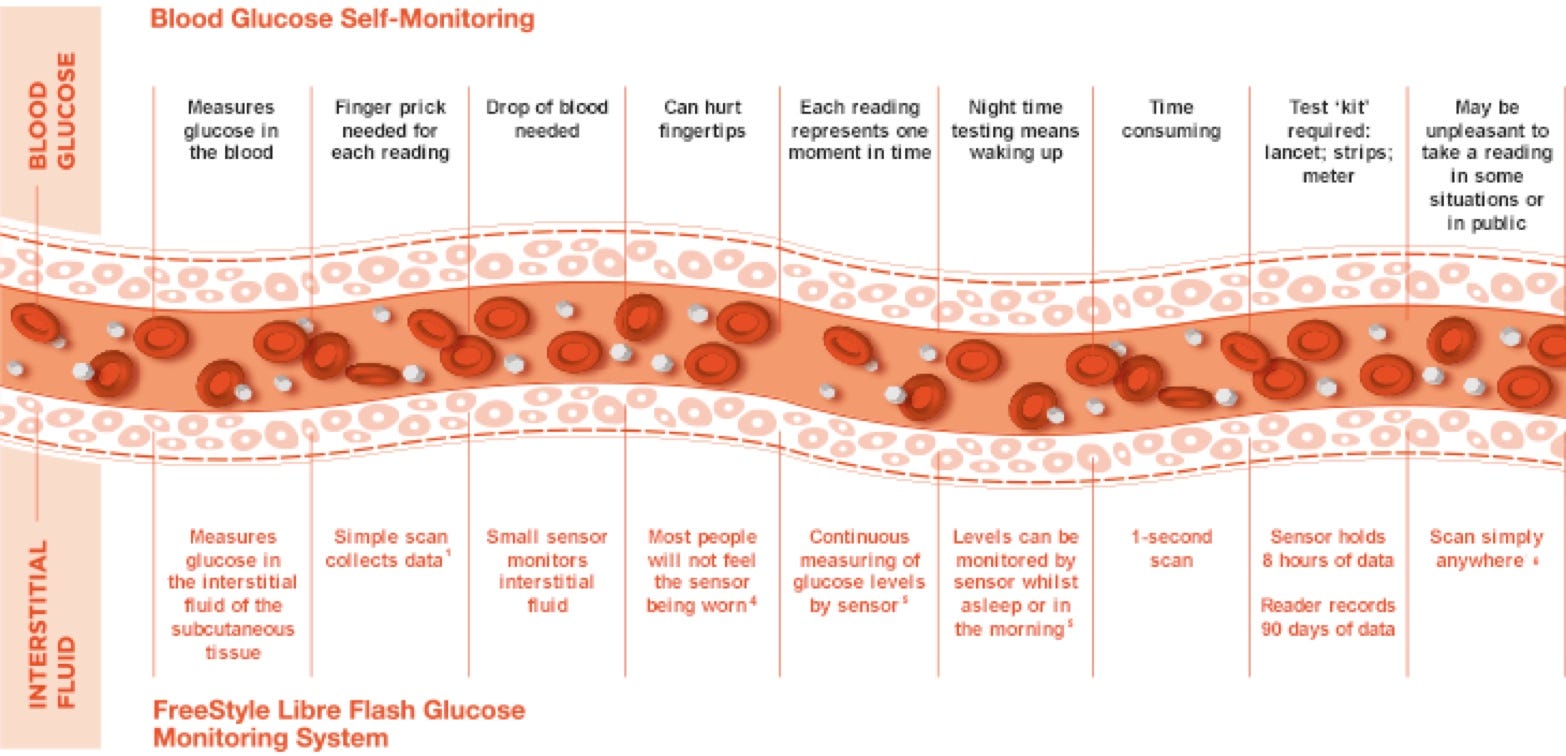GLUCOSE vs INTERSTITIAL GLUCOSE
Finger prick blood glucose readings and sensor glucose reading won't always match and in fact are likely to be different. That's because sensor glucose readings come from the interstitial fluid (ISF), a thin layer of fluid that surrounds the cells of the tissues below your skin, not from your blood. There is a 5 to 10 minute delay in ISF glucose response to changes in blood glucose.4 Glucose readings on ISF have been proven to reliably reflect glucose levels.


Sensor glucose vs blood glucose?
Finger prick blood glucose readings and sensor glucose readings won't always match and in fact are likely to be different. That's because sensor glucose readings come from the interstitial fluid (ISF), a thin layer of fluid that surrounds the cells of the tissues below your skin, not from your blood.
Why does this matter?
Glucose first enters the bloodstream before being absorbed by the interstitial fluid.1 This means there may be a few minutes delay in your sensor (interstitial fluid) glucose readings compared with blood glucose readings. This is called "the lag".1


Blood Glucose Monitoring
Measures the glucose levels in capillary blood vessels.
- A lancet is inserted to reach the blood in the capillary.
- A finger prick only provides one measurement at one point in time.
- Requires a whole kit, including lancets and a blood glucose reader.
The FreeStyle Libre 2 system
Continuously measures the glucose levels in interstitial fluid (ISF): the fluid between the cells under the skin.
- Glucose readings based on interstitial fluid have been shown to reliably reflect glucose levels.
- The sensor is painless to apply and use.
- The sensor takes a glucose reading every minute.
- Monitor your glucose on the go with zero finger pricks^.
Blood glucose reading vs sensor reading
Here's a video tutorial to help show how blood glucose readings are different to sensor readings
1. Basu A. et al. J Diabetes Sci Technol 2015; 9(1): 63-68. DOI: 10.1177/1932296814554797
^ Finger pricks are required if your glucose readings and alarms do not match symptoms or expectations.
Lorem ipsum dolor sit amet, consectetur adipiscing elit, sed do eiusmod tempor incididunt ut labore et dolore magna aliqua. Ut enim ad minim veniam, quis nostrud exercitation ullamco laboris nisi ut aliquip ex ea commodo consequat.
Lorem ipsum dolor sit amet, consectetur adipiscing elit, sed do eiusmod tempor incididunt ut labore et dolore magna aliqua. Ut enim ad minim veniam, quis nostrud exercitation ullamco laboris nisi ut aliquip ex ea commodo consequat.
The FreeStyle Libre system is accurate, stable and consistent over 14 days [1] without the need for fingerprick calibrations.
To assess the accuracy of the FreeStyle Libre sensor, the glucose readings the sensor provides are compared to a known independent reference. In this case the reference is a finger prick blood glucose reading which is taken at the same time as the sensor scan. The comparison between the 2 different readings is plotted on a graph called a Consensus Error grid.
The closer the sensor reading to the reference blood glucose meter reading, the better the accuracy. This is reflected by the Consensus Error Grid by various areas on the graph labelled A to E. The higher the percentage of readings in Zones A and B, the more accurate the sensor is. The consensus Error Grid below shows 99.7% in Zone A and 99.0% in Zone B of the Consensus Error Grid [1].

1. Bailey et al. The Performance and Usability of a Factory-Calibrated Flash Glucose Monitoring System. Diabetes Technology & Therapeutics. Nov 2015; 17 (11).


 FreeStyle Libre 2 Sensor
FreeStyle Libre 2 Sensor FreeStyle LibreLink App
FreeStyle LibreLink App FreeStyle Libre 2 Reader
FreeStyle Libre 2 Reader LibreLinkUp App
LibreLinkUp App  LibreView
LibreView







